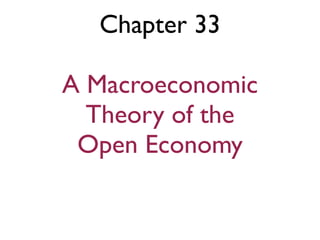
Macroeconomic Model of Open Economy
- 1. Chapter 33 A Macroeconomic Theory of the Open Economy
- 2. Key Terms trade policy capital flight
- 5. Model Simplified version of reality
- 6. Variables Net Exports Net Capital Outflow Real Exchange Rates Nominal Exchange Rates
- 9. Two Markets Loanable funds market Foreign currency market
- 10. Loan Market Savers and Borrowers S = I + NCO Savings = Domestic Investment + Net Capital Outflow Supply = Demand
- 11. Two Things Invest at home Invest abroad
- 12. NCO > 0 Less Invest at home More Invest abroad Investing more in other countries than your own
- 13. NCO < 0 More Invest at home Less Invest abroad Other countries want to invest in your country
- 14. Supply and Demand of Loanable Funds Depends on the real interest rate
- 15. Remember Nominal Rate = Real Rate + Inflation Rate
- 16. Nominal = Real + Inflation N=R+I Country A Country B Country C Nominal 10% 13% 12% Real 8% 10% 5% Inflation 2% 3% 7%
- 17. Interest Rates High Encourage Savers Discourage Borrowers Low Discourage Savers Encourage Borrowers
- 18. Interest Rates Low High Savers Borrowers
- 19. Which Investment? Saudi U.A.E. Nominal Rate 10% 12% Inflation 4% 7% Real Rate 6% 5%
- 20. Market for Loanable Funds Real Interest Too high Rate More supply than demand push rate down Supply From national savings Equilibrium Rate Demand For domestic and foreign Too low investment More demand than supply push rate up Equilibrium Quantity Quantity of Loanable Funds
- 21. Foreign Currency Exchange Market NCO = NX Net Capital Outflow = Net Exports
- 22. Foreign Currency Exchange Market If NX > 0 Selling more than buying What to do with cash? Must buy foreign assets Remember foreign currency is a foreign asset
- 25. Foreign Currency Exchange Market If NX < 0 Buying more than selling Must sell domestic assets to pay for purchases
- 26. Foreign Currency Exchange Market At the Equilibrium Exchange Rate: Demand for currency from foreigners from net exports = Supply of currency from citizens from net capital outflow
- 27. Market for Foreign Currency Exchange High rates discourage exports Real Supply Exchange From net capital outflow Vertical - does not depend on Rate exchange rate Equilibrium Rate Low rates stimulate exports Too high Demand More supply than demand For net exports Pressure to push rate down Too low More demand than supply Pressure to push rate up Equilibrium Quantity Quantity of Riyals Exchanged into Foreign Currency
- 28. Linking The Loanable Funds Market S = I + NCO with Foreign Currency Exchange Market NCO = NX
- 30. Where did the riyals come from? Saudi Savers Loanable Funds Market Where did I buy the riyals? Foreign Currency Market Currency Traders move funds between the two markets
- 31. S = I + NCO demand side NCO = NX supply side
- 32. Net Capital Outflow Depends on Real Interest Rate Real Interest Rate NCO is negative 0 NCO is positive NCI is positive NCI is negative Cash comes in Cash goes out
- 33. Linking Loanable Funds Market Net Capital Outflow Real Supply Real Interest Interest Rate Rate Equilibrium Interest Rate Demand Demand Quantity of Loanable Funds Quantity of Loanable Funds Loanable Funds Market Interest Rate Real Exchange Rate Supply Equilibrium Exchange Rate Foreign Currency Market Demand Exchange Rate Quantity of Riyals Foreign Currency Exchange Market
- 34. Policy Loanable Funds Market Net Capital Outflow Real Supply Real Interest Interest Rate Rate Equilibrium Interest Rate Demand Demand Quantity of Loanable Funds Quantity of Loanable Funds Government deficits Real Supply push up interest rates Exchange Rate which increase Equilibrium exchange rates Exchange Rate which increase trade Demand deficits Quantity of Riyals Foreign Currency Exchange Market
